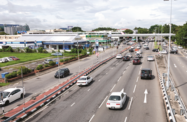A transportation overhaul is under way in Brunei Darussalam, with the government planning initiatives ranging from bus rapid transit (BRT) to road tolls to encourage the use of public transport and improve overall connectivity.
However, further action on fuel subsidies and motor vehicle regulations may be needed to ensure the Sultanate’s plan reaches its full potential.
Safety first
As outlined in Brunei's Land Transport Master Plan (LTMP), launched last December, the government aims to tackle car dependency in the coming years, improving traffic and tightening transport regulations with an emphasis on reducing injuries and fatalities.
Underscoring the growing importance of road safety, in late September government officials announced that the number of road fatalities year-to-date had already reached the 2014 total, with 11 of the 24 deaths recorded in a single month.
The Sultanate’s dependency on cars stems in part from a lack of viable transport alternatives, as well as low import taxes and petrol prices, with unleaded fuel costing just BN$0.53 ($0.38) per litre due to state subsidies. Relatively easy access to credit for car loans also puts car ownership within reach of a large number of Bruneians.
As a result, Brunei continues to have one of the highest rates of car ownership in the world, at 2.65 people per vehicle, with the number of newly registered vehicles increasing by nearly 20% in the two years to 2013, according to the Department of Economic Planning and Development.
Rapid transit in the works
To create viable public transport alternatives, the LTMP plans to create a BN$3.24bn ($2.3bn) BRT system. The line aims to offer affordable fares to promote ridership, with low-income workers, students, the unemployed and senior citizens to be charged BN$0.50 ($0.36) instead of the regular fare of BN$1 ($0.72), according to local media.
The new system will run four lines across the Brunei-Muara District, which is home to more than half the country's population, with 48 km of bus lanes to be completed by 2035 and the first line to open in 2020. Once fully operational, the line’s 126 BRT buses are expected to run every four minutes, with 29,000 trips during peak hours and a total of 228,000 trips per day.
The BRT will also include three public transport interchanges and three “park-and-ride” facilities, where commuters can park their cars and travel by bus.
Additionally, over the next 20 years the LTMP aims to replace and expand the country’s conventional bus fleet, doubling the number of school buses in service and increasing the number of licensed taxis to 400, compared to less than 50 at present.
Other incentives
Other policies could also help incentivise Bruneians to use public transport, according to Pehin Dato Abdullah Bakar, minister of communications.
“If we observe and understand public transportation issues in Brunei and compare them with [other countries], we will see the need to have policies that could pull the public to use public transportation, and push them to [continue] using them,” he said in March, speaking to the Legislative Council.
Among the policy tools being considered by lawmakers are the introduction of road tolls, increasing the cost of parking in urban areas, instituting road taxes and regulating the price of fuel.
The Centre for Strategic and Policy Studies, a local think-tank that helped develop the LTMP, has previously suggested that the removal of fuel subsidies in Brunei could increase public transport ridership by as much as 20%.
Perhaps most crucial to the realisation of the LTMP’s goals is the planned creation of a Land Transport Authority in the Sultanate, which officials hope will provide the necessary oversight and regulation of the land transport sector.
Regional brainstorming
Examples from neighbouring countries could also offer policy ideas for Bruneian officials. For example, Singapore saw some 3.75m passenger trips on public buses each day last year, compared to a population of 5.47m, according to the country’s Land Transport Authority.
This high uptake is thanks in large part to a decades-old area licensing system, which imposes stiff fees for cars entering downtown Singapore during business hours. The Sultanate could also consider a system similar to Singapore’s “Certificate of Entitlement” programme, which limits car ownership by distributing just 30,000 permissions each year.
Oxford Business Group is now on Instagram. Follow us here for news and stunning imagery from the more than 30 markets we cover.

